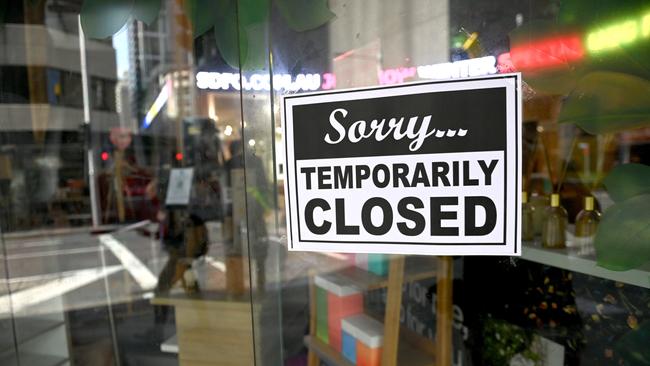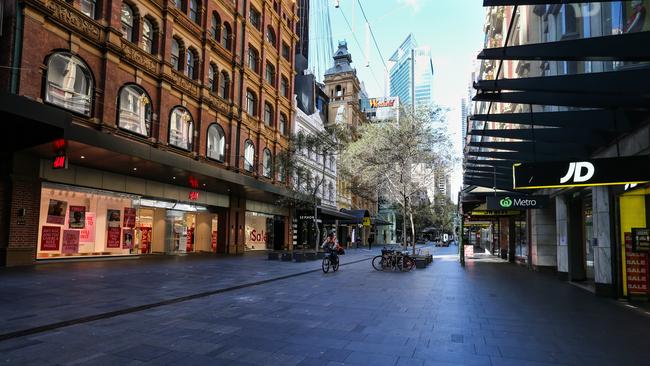‘Pivot needed’ as lockdowns hit confidence
Australia’s economic performance is at risk from ongoing Covid lockdowns.

Australia’s economic performance is at risk from ongoing Covid lockdowns.
With 80 per cent of the elderly now vaccinated at least once and the fatality rate for people under 50 years of age just 0.03 per cent, “there may be an opportunity for policymakers to pivot away from elimination, and towards a mitigation strategy that protects the vulnerable, while easing the severity of lockdowns,” says Deutsche Bank macro strategist Tim Baker.
“But there’s very little sign of appetite for such a pivot among policymakers. Instead, the current elimination goal looks set to stay, weighing on sentiment.”
While predicting a deep contraction in the September quarter, economists will need to further downgrade their forecasts after NSW declared a one-week lockdown of the Hunter region on top of the Greater Sydney lockdown running at least through August, and southeast Queensland remains in one-week lockdown and Melbourne has also announced a new lockdown, its sixth so far.
With NSW reporting a record 262 new locally acquired Covid cases, 45 of which were infectious while in the community, predictions like that from JPMorgan’s Siddharth Parameswaran, that the Greater Sydney lockdown will be extended to the end of September, are more plausible.

There was also an increasing risk of lockdowns spilling into the December quarter, delaying spending and investment decisions and possibly causing a lasting loss of confidence.
In his statement after the Reserve Bank board meeting this week, governor Philip Lowe noted that the economy had rebounded quickly in the past once virus outbreaks were contained.
In a Wall Street Journal interview on Thursday, Melbourne Business School dean and RBA board member Ian Harper said if the economy weakened alarmingly, the RBA could increase its bond buying program – due to be trimmed to $4bn a week next month, from $5bn.
But he expected a December quarter “snapback” rather than two negative quarters of growth, which would meet the standard definition of a technical recession.
Still, Baker says Australia appears to have an “exit strategy that may prove tough to achieve” and ongoing lockdowns may “materially dampen business and consumer sentiment”.
“That suggests Australia’s economic outperformance is over, with risks the post-lockdown bounceback – whenever that is – disappoints the RBA, prompting a dovish tilt.”
While noting that it takes time for new cases to manifest in hospitalisations and deaths, and hospitalisations are rising swiftly, that’s been partly boosted by Queensland admitting all Covid patients.
“Deaths have only ticked up a little, though sadly more may be expected given the lead from cases,” Baker says.
“Still, respiratory hospitalisations and deaths crop up every winter and, while the trends are headed the wrong way, it seems far from levels that would overwhelm hospital capacity.
“Having several hundred in hospital appears to be broadly similar to a normal flu season.”
Baker also sees “grounds for optimism” since many of the deaths came last year, when treatments were less advanced.
The rolling death rate overall was now just 1 per cent, versus 3 per cent in the second half of last year.
Also, while the vaccination rollout is low in aggregate, coverage for the vulnerable age groups is quickly rising to reasonable levels.
With almost 45 per cent of those 70 years and older fully vaccinated, and 80 per cent partially vaccinated, “as they return for second doses in coming weeks, vaccine coverage among the vulnerable should get very high”.
But for now, Australia has the strictest restrictions among G10 countries and for much of the past month over a third of the country has been locked down.
“That seems to be starting to weigh on consumer confidence – it’s as low as it’s been in a decade, with the big exception of the plummet in 2020,” Baker says.
“That doesn’t bode well for consumer spending, and retail sales have already been essentially flat for six months.”
While the federal government is charting a “course to normality”, with an intermediate vaccination target of 70 per cent among adults, he notes it’s not clear this target will be adhered to.
While promoted by Scott Morrison, it’s the state premiers that have been locking down communities and closing state borders as is within their power.
The vaccine supply is rising and the rollout is accelerating, such that, based on the path of other OECD countries, Australia could hit its desired vaccination coverage in November or earlier.
But some OECD countries still haven’t reached the 70 per cent target for adults.
“It seems the ‘final mile’ can be difficult, as a core of citizens remain concerned about the jab,” Baker says.







To join the conversation, please log in. Don't have an account? Register
Join the conversation, you are commenting as Logout